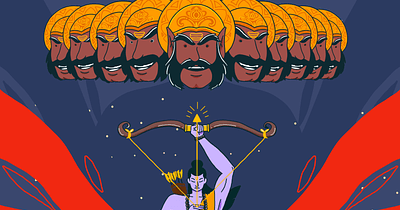The Truth Behind Ram and Ravan: What They Didn’t Teach You

As Indians, regardless of our diversity, one truth that all of us can agree on is how We all grew up with the Ramayana, either hearing it from our grandparents or watching it on TV.
Ram was the perfect son, the ideal king. Ravan? The villain who kidnapped Sita and got what he deserved. But the more you dig into the story, the more you realize that our scriptures weren’t trying to present an all it's black and white picture. There are layers, choices, and even regrets that don’t always get spoken about.
This blog is not about changing your beliefs—it’s about looking at the story from a slightly different lens. One that feels more human.
Let’s start with the basics. Lord Rama who is the prince of Ayodhya, is exiled for 14 years due to a promise made by his father king dashratha. During his exile, his wife Maa Sita is kidnapped by Ravan, the demon king of Lanka. Shree Ram, with the help of Hanuman and the vanar sena, defeats Ravana and rescues Sita. Simple, right? But maybe... too simple?
Ravan: The Scholar, Not Just the Villain

Here’s what is often skipped ! Ravan wasn’t just some evil king. But rather he was a brilliant scholar, a master of the Vedas, an incredible musician, and a staunch devotee of Lord Shiva. Yes, his ego and arrogance were his downfall, but he also had a mind that people respected. Even Ram asked Laxman to sit beside Ravan as he lay dying to learn from him. Think about that: the "villain" teaching the hero’s brother in his final moments.
And his capabilities by no means diminish the wrongs that he has done. What he did—kidnapping Sita—was wrong. No doubt. But the man behind the action was far more complex than a one-line label of “evil.”
Shree Ram: The Ideal King, but Also Human

We’ve always been taught to admire Ram—and rightly so. But even Ram had to make decisions that were... difficult to accept. After winning the war, when Sita returned, he asked her to prove her purity through the Agni Pariksha. Later, despite her passing the test, he sent her away to the forest just because some citizens doubted her.
Why would an “ideal” man do this?
Maybe because being a king, he had a duty towards thousands of people that trusted him and believed him as their true ruler. That doesn’t make him less admirable, it just makes him real and even more courageous. Someone who made a decision that scarified his personal wishes for his citizens.
Different Stories, Different Views
Did you know that in some South Indian and Sri Lankan versions of the Ramayana, Ravan is seen in a more respectful light? That in some tribal tellings, Sita is even said to have been Ravan’s daughter, abandoned and then found by Janak?
Each region, each tradition, adds its own layers to the story. It’s not about which one is “true”—it’s about realizing that mythologies evolve and reflect different truths to different people.
So, Why Talk About This Now?
Because we live in a world that still loves to label people: good or bad, right or wrong. But life—like the Ramayan—is rarely that simple. Ram and Ravan both made great choices and terrible ones. And maybe that’s the point. Maybe our stories are meant to show us that everyone is a mix of strength and flaw. We don’t need to choose sides. We need to understand the full picture.
Conclusion

The story of Ram and Ravan is more than just a tale of good versus evil. It’s a window into Ramayana’s lesser-known facts, deep symbolism, and powerful moral lessons that still shape our culture today. As we explore different Ramayana versions, uncover the truth about Ram and Ravan, and reflect on their legacy, we realize that this ancient epic holds more questions than answers.
From Ravan’s real story to Ram’s true nature, from myth to history, and through centuries of interpretations and controversies, the Ram and Ravan rivalry continues to spark debate and teach us valuable lessons. These aren’t just characters—they’re reflections of our own struggles, decisions, and values.
Maybe that’s why the Ramayana story, in all its forms—from folklore to philosophy—still matters. Because hidden in the Ram and Ravan mythology is not just a story, but a mirror.




